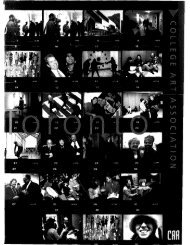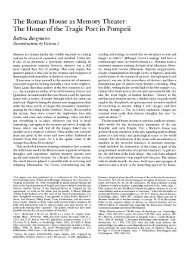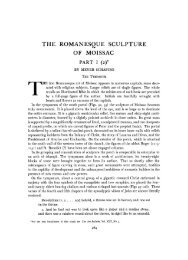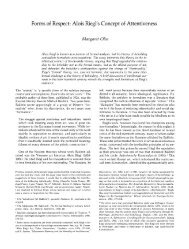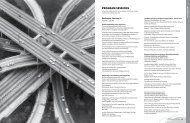THE HUMANISTIC THEORY OF PAINTING - College Art Association
THE HUMANISTIC THEORY OF PAINTING - College Art Association
THE HUMANISTIC THEORY OF PAINTING - College Art Association
Create successful ePaper yourself
Turn your PDF publications into a flip-book with our unique Google optimized e-Paper software.
UT PICTURA POESIS: <strong>HUMANISTIC</strong> <strong>THE</strong>ORY <strong>OF</strong> <strong>PAINTING</strong> 213<br />
imitating God whose most perfect work is also man, paints groups of human figures and<br />
chooses subjects from history and fable. "He must," writes F6libien, "like the historians,<br />
represent great events, or like the poets, subjects that will please; and mounting still<br />
higher, be skilled to conceal under the veil of fable the virtues of great men, and the most<br />
exalted mysteries.""7 Less than forty years later, at the beginning of the eighteenth cen-<br />
tury, this humanistic point of view had already begun to change and to point toward the<br />
still distant Romantic Movement, when the forward-looking critic Roger de Piles daringly<br />
extended the meaning of "historical invention" to include any choice of objects that<br />
"simply of themselves represent a subject for the painter."" It would have been in the<br />
interest of clarity had De Piles allowed the term to retain its original connotation of "having<br />
to do with fable," and invented a more appropriate category in which to place still-life and<br />
landscape painting. But if his new and inclusive use of it is not particularly apt, his desire<br />
to extend the welcome of criticism to those essentially pictorial provinces of the painter's<br />
art that the Academicians strenuously bred in the tradition of classicism-and of ut pictura<br />
poesis-had hitherto considered little more than hack-work, is historically very significant.<br />
At the end of the eighteenth century Reynolds, who combined allegiance to the grand style<br />
of historical painting with a breadth of outlook that recalls De Piles, said all that it is neces-<br />
sary to say in criticism of the academic hierarchy of the styles when he remarked: "Whether<br />
it is the human figure, an animal, or even inanimate objects, there is nothing, however<br />
unpromising in appearance, but may be raised into dignity, convey sentiment, and produce<br />
emotion, in the hands of a painter of genius. What was said of Virgil, that he threw even<br />
the dung about the ground with an air of dignity, may be applied to Titian: whatever he<br />
touched, however naturally mean, and habitually familiar, by a kind of magic he invested<br />
with grandeur and importance."80 Reynolds' point would have greater force for the modern<br />
reader had he chosen Chardin rather than Titian as an illustration, although Chardin<br />
would certainly not have been so perfect a pendant to Virgil. But no liberal humanist of<br />
today will deny that individual genius is a more important factor than choice of subject<br />
matter in producing painting that is humanly significant, even though he will not admit-<br />
78. See F61libien's preface to his Confirences de l'Acadimie<br />
Royale de Peinture et de Sculpture, Paris, 1669. The Confirences<br />
are reprinted in vol. v of the edition of his Entretiens<br />
sur les vies et sur les ouvrages des plus excellens peintres<br />
published at Trevoux in 1725; I quote from p. 310: "Il est<br />
constant qu'a mesure qu'ils [painters] s'occupent aux choses<br />
les plus difficiles et les plus nobles, ils sortent de ce qu'il y<br />
a de plus bas et de plus commun, et s'anoblissent par un<br />
travail plus illustre. Ainsi celui qui fait parfaitement des<br />
paisages est au-dessus d'un autre qui ne fait que des fruits,<br />
des fleurs, ou des coquilles. Celui qui peint des animaux<br />
vivans est plus estimable que ceux qui ne repr6sentent que<br />
des choses mortes et sans mouvement; et comme la figure<br />
de l'homme est le plus parfait ouvrage de Dieu sur la terre,<br />
il est certain aussi que celui qui se rend l'imitateur de Dieu<br />
en peignant des figures humaines, est beaucoup plus excellent<br />
que tous les autres . . un Peintre qui ne fait que des<br />
portraits, n'a pas encore atteint cette haute perfection de<br />
l'<strong>Art</strong>, et ne peut pr6tendre A l'honneur que recoivent les plus<br />
sgavans. Il faut pour cela passer d'une seule figure A la<br />
repr6sentation de plusieurs ensemble; il faut traiter l'histoire<br />
et la fable; il faut repr6senter de grandes actions<br />
comme les Historiens, ou des sujets agr6ables comme les<br />
Poites; et montant encore plus haut, il faut par des compositions<br />
all6goriques, sgavoir couvrir sous le voile de la<br />
fable les vertus des grands hommes, et les mysteres les plus<br />
relevez. L'on appelle un grand Peintre celui qui s'acquitte<br />
bien de semblables entreprises." F61ibien's remarks on allegory<br />
derive from the Renaissance theory of epic poetry,<br />
which was, of course, current in the seventeenth-century<br />
France. The epic was supposed to contain a hidden meaning<br />
beneath the veil of the action. See Spingarn, op. cit., pp.<br />
10o7.<br />
79. De Piles is still conservative enough to remark that<br />
it is reasonable to consider a history (he means a history<br />
in F61ibien's sense of the term) the highest kind of painting,<br />
and that it is usual to contrast a history with a painting of<br />
beasts, or of landscape, or of flowers, etc. Nevertheless, in<br />
including under the term "historical invention" (in contrast<br />
to what he calls allegorical, and mystical invention),<br />
true and fabulous history, portraiture, views of countries,<br />
beasts, and all the productions of art and nature, he is<br />
saying something new; and he shows a highly complimentary<br />
attitude toward the painter even of "the flower, fruit,<br />
plant, and insect" in remarking that even subjects such as<br />
these, that are not found in books or established by tradition,<br />
make demands on the painter's intelligence and inventive<br />
genius, and, he adds (and this is an old-fashioned compliment<br />
that no seventeenth-century Academician would<br />
have given any painting but a history in the strict sense<br />
of the word), are capable of yielding instruction. See Cours<br />
de peinture, pp. 53-55.<br />
8o. Discourse XI.



